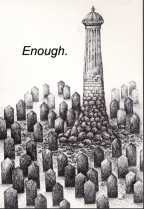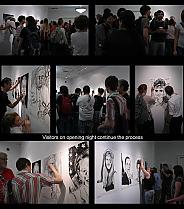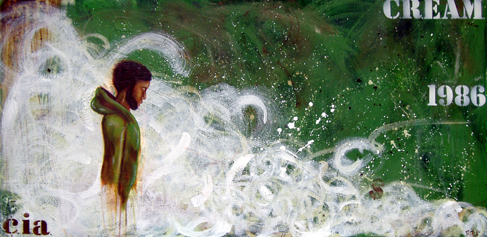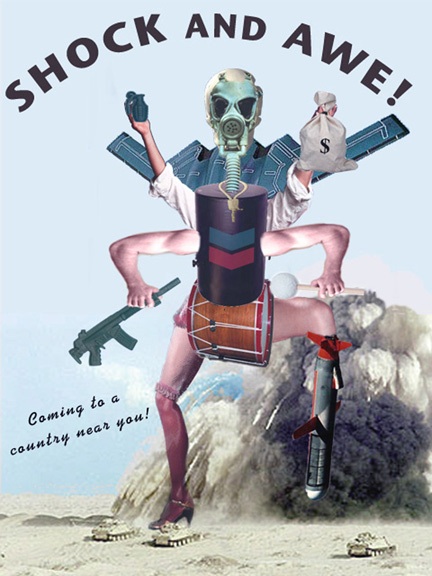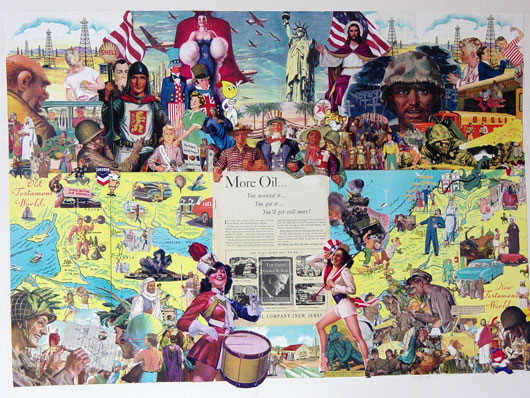Art Now Home | About Art Now | Artists Respond to the Political Present | Approaching the Aftermath & Commemorating Sept. 11 | Related Sites & Resources | Contact Art Now
Artists Respond to the Political Present
Events | Dance | Film, Video, TV | Internet & Electronica | Music | Theater, Performance Art & Protest | Visual Art | Words
Visual Art
Comics & Political Cartoons | Flags & Quilts | Group Exhibitions | International Artwork of Protest | Magazines | Murals | Painting & Collages |Participation Art Work | Photography | Poster Art | Sculpture & Installations | Web Sites

Chump Change, Alvaro Alvillar ENOUGH., Gayla Lemke
Home On The Range, Marcia Annenberg Yankee Doodle Went to Town. Marcia Annenberg
Marcia Annenberg‘s Home On The Range focuses on the American addiction to TV and film; a lifestyle of escapism. My painting utilizes Grant Wood’s iconic “American Gothic” to reveal this recent shift in the American lifestyle, by re-positioning the central figures in his composition. The TV in the center symbolizes media and news that is centers almost exclusively on the domestic at the expense of an international awareness. Yankee Doodle Went to Town refers to the no-bid contracts awarded to Halliburton at the start of the war – a transparent collusion of corporate and political power.
Bill Fisher, in association with Art of Democracy, displays “Executive Branch Suite: Phase II” at the Georgia College Museum from October 15 to December 5, 2008. “Using the materials supplied in the gallery or brought from home, please add your marks and erasures to the work done by those who have come before you. You are encouraged to consider your decisions, reflect upon your choices, and invite others to participate during the run of the exhibitions.”
Antoine Williams
Charlotte, NC
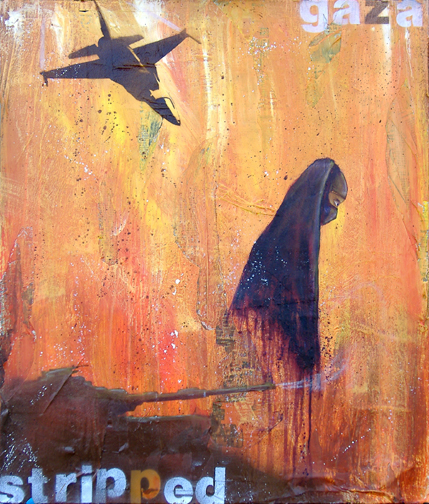 |
|
Karen Fiorito
Los Angeles, CA
www.lilfury.com
www.hardpressedstudios.com
|
|
Holly Wong depicts civilians experiencing the suffering of war because she feels that civilians (especially women and children) are the greatest victims of war; in many instances, they have no part in the war, yet suffer the dire consequences of it. The “War on Terror” profoundly changed her work because she understood that her own country was assaulting civilian populations and if she made no statement of protest, she felt she would be complicit in it. Art has always been her voice of resistance; it her way of making a contribution as a citizen. In her mother’s time, Vietnam was the immoral war and people marched and gave up their lives in many instances because they knew that the war was illegal; the Iraq war is her generation’s moral question and she must do no less than what others have done before her.
|
“He’s Not Heavy, He’s My Brother” depicts an older brother carrying his dead younger brother away in war-torn Iraq. Like Wong’s other images, this depicts the suffering of civilians but also the incredible tenderness and love that is felt between these two individuals. Since love is universal, she hoped that the viewer can relate to the feelings of tenderness and relate to the loss that the older brother feels. In addition, Wong wanted to portray the chaos of the environment through the swirling energy of the marks and the older brother’s determination to carry his younger relative to safety. |
 |
“Search in Iraq” was based on news footage of an Iraqi women being searched by U.S. forces. Wong was moved by the feeling of indignity in the woman’s face as the soldier’s hands are positioned just above her breasts. The original footage shows both the soldier and the woman, but Wong wanted to focus only on the woman and the soldier’s hands. Thus, she made the woman’s face the focus of the image with her expression a mixture of fear, shame, anger and resignation. The emphasis is on the terror she feels and the anonymity of the hands that touch her without her consent. Wong used bright colors for her clothing and an ornate pattern for her hijab to bring more individuality to this woman being anonymously searched at a checkpoint.
|
 |
In “Trashpickers,” Wong portrays women and adolescent boys picking through trash because of the unemployment problems in post-invasion Iraq. Because of the high rate of unemployment, many are left to salvage through trash for food along with their children. Wong wanted the adolescents and the women in the painting to demand more from the viewer with their expressions. Wong depicted the landscape as tumultuous and polluted because she thought that it better reflected the living conditions of Iraq.
|
A thief stole a cassette tape featuring a message about the Homeland Security Act that was part of Mary Golden’s “Kitchen Diplomacy,” created for the “Peace Offerings, Winter Solstice 2002” exhibit at the Boulder Public library. The tape featured Golden’s recitation of an article by William Safire of the New York Times discussing that as it now stands, the Homeland Security Act could enable the government to access people’s private lives. Golden decided to display a note next to the artwork stating, “This tape was stolen by a censor who did not want you to hear it.” “Kitchen Diplomacy” features a transparent chessboard above a map of the Middle East. On each end of the chessboard are salt and pepper shakers, representing armies and governments, one with black beans and the other with white rice. Behind the salt and pepper shakers is a representation of a child from each country symbolizing each country’s people. The work also features a piece of metal which is used both by the poor in constructing their homes and by the rich in decorating their homes. This is the library’s second incident of censorship, the first occuring in Nobember of 2001 when Bob Rowan removed ceramic phalluses after the library refused to hang an American flag by the entrance to the library. (reported in The Daily Camera, www.dailycamera.com)
Jos Sances, a Berkeley based artist, created various parodies of Thomas Kinkade works. Depicted in the painting, “Roll On or Neil Young’s an asshole” are doors which open to reveal politically charged images including images of a naked woman in front of a Confederate flag with her legs spread and a cross covering her genitals. Another door reveals a receipt from Wal Mart listing: “Where’s Osama Toliet Seat for $14.97 and a B-1 bomber for $1,000,500,321.87. Sances exhibited these paintings at the Fetterly Gallery in Vallejo, California from Memorial Day to July 4, 2002. The Fetterly Gallery is used by the Harvest Free Will Baptist Church on Sundays. The room in which Sances’ paintings are exhibited is utilized by the Church as a day care room. Sances states that “I made pictures that question our uniform response. I won’t even tell you whether they are things I believe in. That’s not the point.” (reported in the San Francisco Chronicle on Sunday, June 9, 2002)
 |
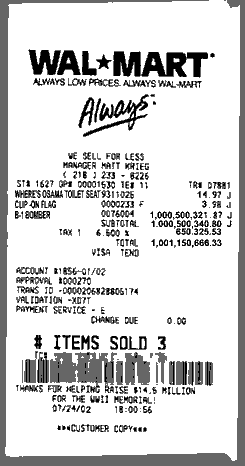 |
|
Jos Sances, Roll On, or Neil Young’s An Asshole
|
Jeff Greenhut:
 |
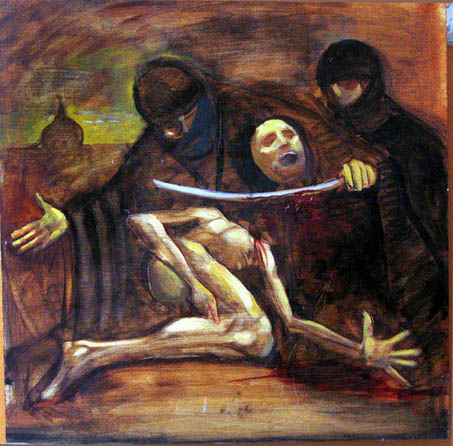 |
| Jeff Greenhut, W | Jeff Greenhut, Wahabi Nightmare |
Joshua Waldman:
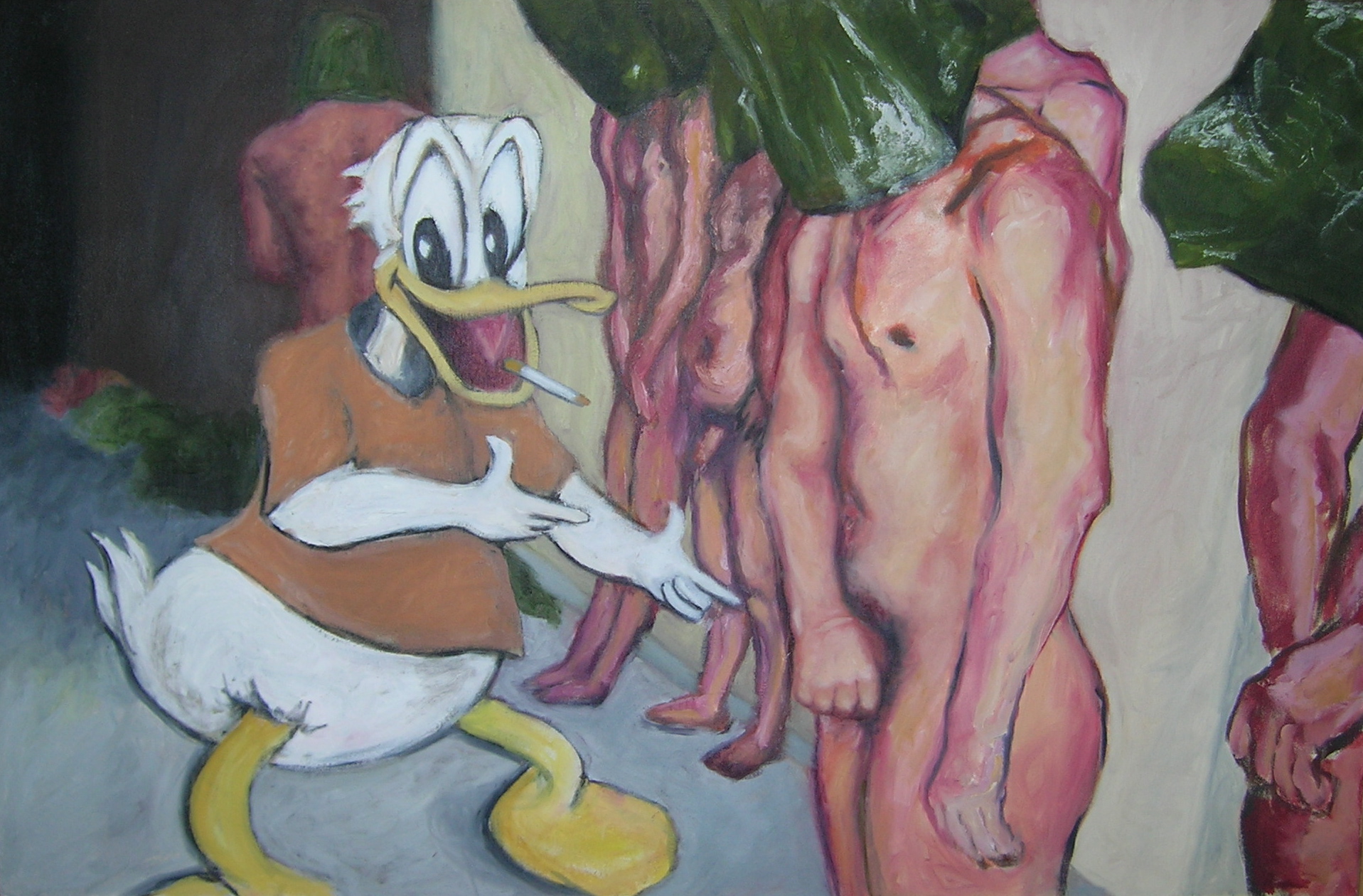 |
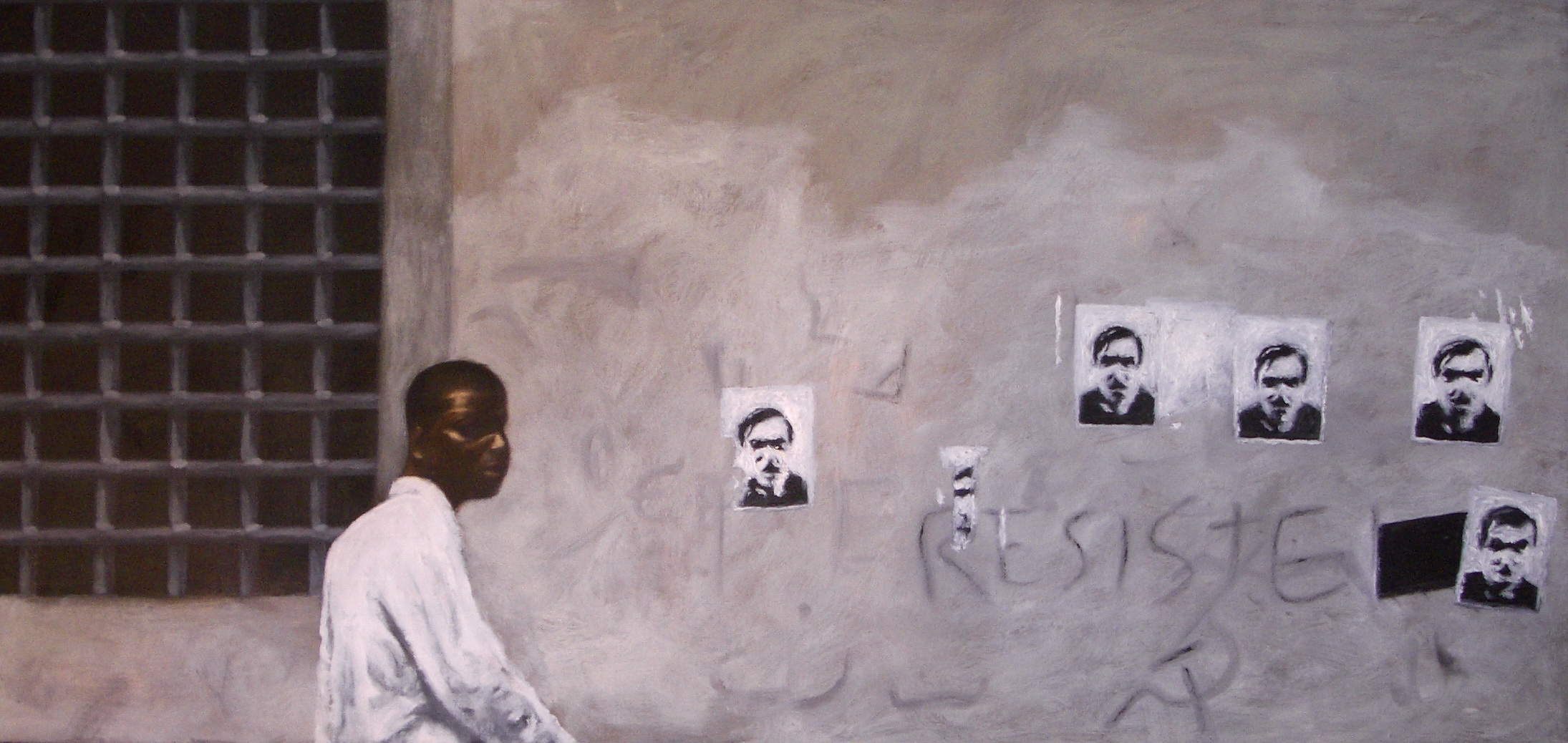 |
Holly Wood’s work is a kind of narrative about the Universe as she experiences it. It falls within the same genre of satire and commentary on the Human Condition as artists like Goya, Daumier, Hogarth, and Grosz. The artist is inspired by observation of daily life, news stories, history and her own dreams. Below is Wood’s works “Anthrax Afternoon” and “Anxiety.”
 |
 |
|
Holly Wood, Anxiety
|
Holly Wood, Anthrax Afternoon
|
Jamie Gagan frequently uses political elements in her work, actively challenging viewers to question their own role in the current state of the world. She believes that art has a role in questioning the status quo; challenging individuals to reassess their personal values. As revealed through her artwork, the artist remains optimistic, encouraged and heartened by the incredible potential of the human spirit to prevail and trancend unthinkable conditions.
 |
 |
|
|
| “The 5th Crusade” by Daniel Hauben
|
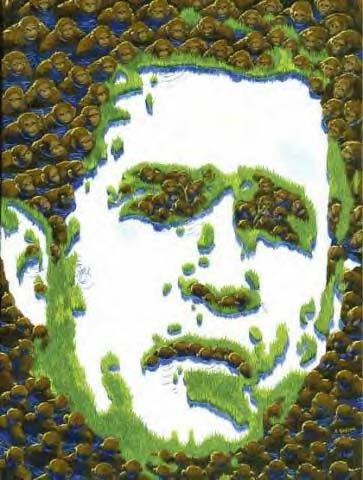

“When people ask me why do I turn the image of the U.S. Capitol building upside down in my collages, as if it were a bomb, my short answer is: It’s upside down because they’re upside down; or even now, I can point to the two thousand one presidential election of George W. Bush by the Supreme Court and NOT THE PEOPLE! (I can’t think of anything more upside down than that). ?. whenever I’m watching the news on television being reported from the nation’s capital, Washington D.C., the person doing the reporting always has the U.S. capitol building behind t??«[ as a backdrop, set design, in the theatre of white supremacy. ?it is the bricks of our black and red bones that built this country’s capitol and its capital. From then on I knew I had to strike back with the only weapon I had: my art.” (From Theodore Harris’ Artist Manifesto)
 |
| On the Throne of Fire after “Somebody Blew Up America” (for Amiri Baraka) collage, 2002. Theodore A. Harris |
BUSH-WHACK! From October 1st through Election Day November 2nd, the George Adams Gallery, 41 West 57th Street 7th Floor, New York, is presenting an exhibition titled “Bush-Whack!” featuring politically responsive work by 14 artists. Bush-Whack! is unapologetically partisan and expresses the views of the George Adams Gallery. The exhibition includes new works by gallery and invited artists critical of President George W. Bush as well as historical works that address the presidency of George Bush Sr.
 |
|
James Barsness, No Child Left Behind, 2004
|
Participating artists include Robert Arneson, James Barsness, Yoan Capote, Enrique Chagoya, Sue Coe, Patricia Dahlman, Bart de Koning Gans and Mitchell Marco, Lesley Dill, Diane Edison, Jon Haddock, Rajkamal Kahlon, Anthony Kulig, Andrew Lenaghan, Trong Nguyen, David Sandlin, Peter Saul, and Erika Wanenmacher.
The Kennedy’s, Lyndon Johnson, Richard Nixon, and Ronald Reagan (as Governor of California) all figured prominently in Peter Saul’s paintings of the 1960s, and Saul later reprised his depiction of Reagan as president during the 1980s. While he opted out of artistically skewering George Bush Sr. (“Too boring”), this past year Saul completed a painting of George W. Bush, which depicts Salvador Dali urinating in the President’s ear, will be on view in “Bush-Whack!”
During the 1980s and 1990s, both Robert Arneson and Enrique Chagoya produced works critical of presidents Reagan and Bush Sr. In 1991, for example, Robert Arneson responded to the first Gulf War with a series of images caricaturizing then-President Bush, focusing on his oil interests as the true motivation for the war in Kuwait. “Wimp Dip,” for example, a large-scale painting included in the current exhibition, shows the ex-president covered in oil. With similar sentiments, in 1989 Chagoya produced “Double Agent,” (included in the current exhibition), a billboard size drawing of George Bush, Sr. as Superman with x-ray vision, a reference to the ex-president’s CIA affiliations. And in his recent series entitled “Poor George (After Philip Guston),” Chagoya updated Guston’s 1971 series by replacing Nixon with the equally hapless figure of George W. Bush.
 |
|
Jon Haddock, Wounds of an Iraqi Child Transferred to the American President, 2004
|
Santa Fe based artist, Erika Wanenmacher has also created work critiquing both Bush presidents. “Warhead”(1992), an intricately wood carved portrait of Bush Sr. with a smiling grimace plastered on his face, opens up to reveal a violent, war-torn scene. More recently, Wanenmacher has integrated her political sentiments into the piece “Manifest Destiny,”(included in the current exhibition) a two-part work with a framed hand-colored print of Jesus guiding a young ship captain juxtaposed with a wood carved and fimo sculpted shipwreck.
Other artists have created new work specifically for the exhibition. For example, Andrew Lenaghan’s “Portrait of GWB” is based on a photograph of the president using a chainsaw at his Crawford Ranch. Rendered in a style similar to the Saddam Hussein propaganda paintings done during the dictator’s reign, the large-scale painting subverts any notion of homage with the prominent addition of an earplug in Bush’s ear.
Images can be viewed on the gallery’s website at www.artnet.com/gadams.html and on the Art Dealers Association website, www.artdealers.org.
NEWS FROM HOME – Curated by Moniek Voulon – Exhibition at White Box The Annex – 601 West 26th Street-14th floor-Manhattan-Chelsea-New York, October 9 through November 5 – 2004
Moniek Voulon and 23 other artists from New York and Europe observe in a global and reconstructive way the rebuilding of the world according to the imaginative vision of Bush. They observe the utopias and the spiritual and intellectual projects of Wolfowitz and Rumsfeld. They observe the idea of the regeneration of Arabia by America and the confrontation of the Biblical Imagery with the abstract visuals of the Muslim Koran. And they observe how the ideas of Orientalism and Occidentalism, the two most fundamental political positions of today, dominate the scene at the American frontier in Iraq.
Participating artists: FRANCO ANGELONI – HENK BOVERHOFF – JIM COSTANZO – DORINE VAN DELFT – MATT DUCKLO – ARTHUR ELSENAAR – SIMON FERDINANDO – ATOUSA B. GHIASABADI – LEON GOLUB – KIM GORDON – PAUL GROOT – ELIN O’HARA SLAVICK – KIMBERLY LEWIS – ROBERT LONGO – MILTOS MANETAS – DAISUKE NISHIMURA – YOKO ONO – FEDERICO D’ORAZIO – REMKO SCHA – DAVID SMITHSON – JEROME SYMONS – MAI UEDA – BABETH M. VANLOO – MONIEK VOULON
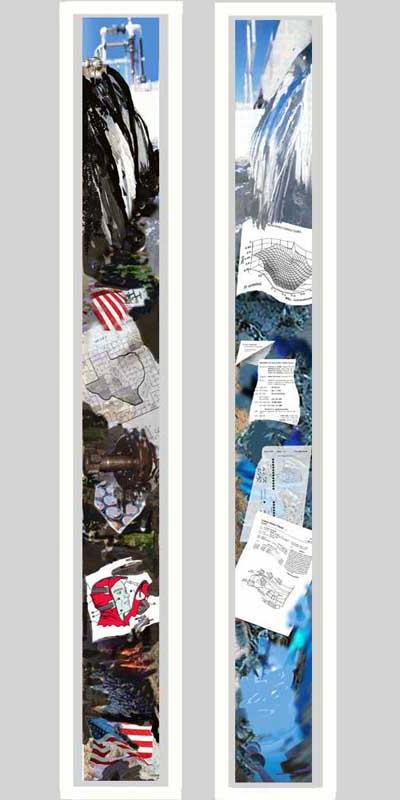 |
Ellen Levy is a New York–based artist and teacher. In her current work, she creates genealogies of inventions by tracking the evolution of related technological innovations, such as nuclear shelters. Her patterns reflect the ongoing adaptations inherent in patented inventions over a roughly two-hundred-year span. She generates digital prints that consist of layered and transformed images and text drawn from a database of registered patents; she then further transforms these with paint. She notes, “I use patents in my monoprints with the deliberate intent to provoke controversial thinking: I select inventions related to nuclear energy, the ecosystem, the space station, and the patenting of new life forms. The finished prints suggest a complex, evolutionary portrait of how economic competition and innovation develop over time.”The work shown here is Oil and Water #1: two scrolls, print and mixed media. |
|
|
Scott Ehrisman has developed into one of the most high- profile artists currently working in the Sioux Falls, South Dakota area. He is an acknowledged leader among the more cutting-edge artists within the local art community and is a co-founder of the Midwest Artist Collective, an artist’s group that offers one alternative to the more established and traditional local art organizations. Ehrisman is also known as a cultural media critic who has written numerous insightful articles on art and popular culture. Wannabe and American 101 are two of his most recent works reflecting on our country’s present political atmosphere.
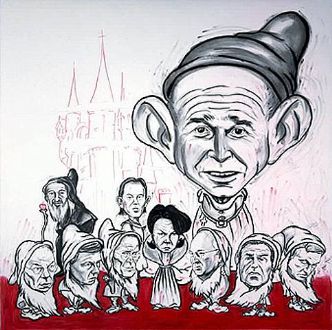




Kara Maria’s work reflects

John Roos calls himself a grass roots artists. His aim is to be a “liver of life.” His technique is placing the viewer of his work in touch with the art of everday. Highways, french fries and skylines are his subject matter and his work is reactionary, responding to visual syntax that confronts us daily; like the new “Dirty Bombs,” which go off all around us- our automobiles. Other images include “In Cars We Park,” “Did Iraq have WMDs,” and “Home Land Security.” Recently Roos was prevented from flying United Airlines while shipping his paintings because they disturbed the security guards and containted wire in the frames. Although that forcible delay caused him to miss his gallery’s openning, you can witness his work now at the PRO (test) AMERICA art opening at the Wheelbarrow Gallery, 3553 Brighton Blvd., Denver, CO.
Jos Sances recent work, including “Roll On, or Neil Young’s an A–” and “Holiday Home,” raised a big fuss when it opened at the Fetterly Gallery in Vallejo, CA. Images include a tank rolling over a bridge, while snipers skulk underneath the ivy as a gunboat approaches. Open the picture-within-a-picture windows and see these politically charged messages: a ’50s family blaming war on “silly scriptures,” a nude woman spread-eagle in front of a Confederate flag with a cross covering her genitals, and a doctored Wal-Mart receipt with the printout “Where’s Osama Toilet Seat $14.97” and “B-1 Bomber $1,000,500,321.87.”
Krystal Higgins: Recently, in an exhibition at my school, a piece that I created in response to 9-11 was set to be put on display. Unfortunately, the illustration advisors felt that my piece was too “controversial” (while my classmates had produced nostalgic pieces, I chose to illustrate how the government was invading our personal entertainment choices in order to exclude anything ‘controversial’ or violent), and refused to hang it among the others. I am now a junior at the Maryland Institute, College of Art in Baltimore, MD.
Patti Smith: Smith’s World Trade Center drawings — a series of silkscreens that document the view from her window of a shard of the North tower — will appear in a retrospective of her art work at the Warhol Museum in Pittsburgh in 2003. As reported in The New Yorker (March 11, 2002): “Dense calligraphic lines of poems and phrases wind along the silk-screened ribs of the wrecked tower.”
Imagine: Nancy Spero’s “Imagine,” in which haunting images of women covered in burqas seem to float within the landscape, was featured on the postcard for the IMAGINE: IRAQ plays. Now, you can see the image, along with Spero’s other works at Galerie Lelong, 528 W. 26th St., NYC, 212-315-0470. Feb 7 – Mar 16, 2002.
| Elizabeth M. Granton: “My artwork is an intersection between painting, collage, and sculpture. It is autobiographical–about my feelings and experiences. Expressing feminism is a predominant intent; to protest social injustices.” | 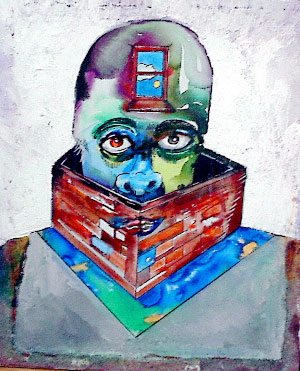 |
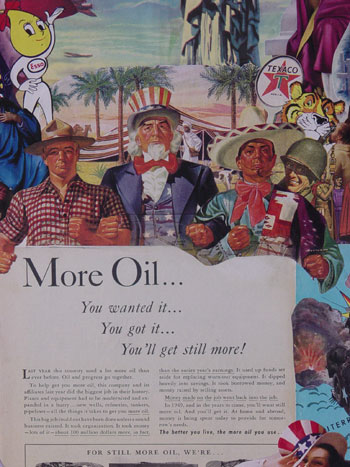 |
Sally Edelstein: “The primary focus of my work is to deconstruct myths, and examine social fictions and incongruities. My work itself is a blend of conceptual art – idea oriented, often word based, with an overlay of pop. The art work is made up of all sorts of banal images, once familiar to the point of invisibility and putting them in a place of prominence, forcing the viewer to re-evaluate their original contexts and original meanings. Using the distance created by time and change of social context, I can show how society’s icons and ideas functioned as propaganda and what they mean to us now in our current context.” She describes “Oils Well That Ends Well” (2006), shown below and at left (detail) as follows: “Despite pretensions to motivations such as liberty and freedom, petroleum and its geopolitics have dominated Anglo American activity in the Middle East for a full century. A potent change in this country’s domestic and foreign policy, however, is Religion’s new political prowess and its role in the projection of military power.” |



